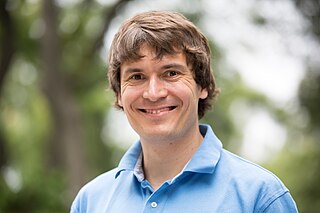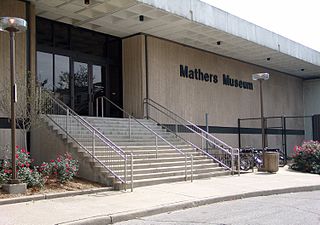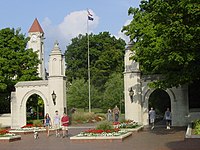Related Research Articles
In computing, a compiler is a computer program that translates computer code written in one programming language into another language. The name "compiler" is primarily used for programs that translate source code from a high-level programming language to a low-level programming language to create an executable program.
Instructional design (ID), also known as instructional systems design (ISD), is the practice of systematically designing, developing and delivering instructional materials and experiences, both digital and physical, in a consistent and reliable fashion toward an efficient, effective, appealing, engaging and inspiring acquisition of knowledge. The process consists broadly of determining the state and needs of the learner, defining the end goal of instruction, and creating some "intervention" to assist in the transition. The outcome of this instruction may be directly observable and scientifically measured or completely hidden and assumed. There are many instructional design models but many are based on the ADDIE model with the five phases: analysis, design, development, implementation, and evaluation.
The Perseus Digital Library, formerly known as the Perseus Project, is a free-access digital library founded by Gregory Crane in 1987 and hosted by the Department of Classical Studies of Tufts University. One of the pioneers of digital libraries, its self-proclaimed mission is to make the full record of humanity available to everyone. While originally focused on the ancient Greco-Roman world, it has since diversified and offers materials in Arabic, Germanic, English Renaissance literature, 19th century American documents and Italian poetry in Latin, and has sprouted several child projects and international cooperation. The current version, Perseus 4.0, is also known as the Perseus Hopper, and is mirrored by the University of Chicago.

The Heinz College of Information Systems and Public Policy, also known as Heinz College, is the public policy and information college of Carnegie Mellon University in Pittsburgh, Pennsylvania. It consists of the School of Information Systems and Management and the School of Public Policy and Management. The college is named after CMU's former instructor and the later U.S. Senator John Heinz from Pennsylvania.

The Newberry Library is an independent research library, specializing in the humanities and located on Washington Square in Chicago, Illinois. It has been free and open to the public since 1887. Its collections encompass a variety of topics related to the history and cultural production of Western Europe and the Americas over the last six centuries. The Library is named to honor the founding bequest from the estate of philanthropist Walter Loomis Newberry. Core collection strengths support research in several subject areas, including maps, travel, and exploration; music from the Renaissance to the early twentieth century; early contact between Western colonizers and Indigenous peoples in the Western Hemisphere; the personal papers of twentieth-century American journalists; the history of printing; and genealogy and local history.
The Five Colleges of Ohio, Inc. is an American academic and administrative consortium of five private liberal arts colleges in the state of Ohio. It is a nonprofit educational consortium established in 1995 to promote the broad educational and cultural objectives of its member institutions.
In library and archival science, digital preservation is a formal endeavor to ensure that digital information of continuing value remains accessible and usable. It involves planning, resource allocation, and application of preservation methods and technologies, and it combines policies, strategies and actions to ensure access to reformatted and "born-digital" content, regardless of the challenges of media failure and technological change. The goal of digital preservation is the accurate rendering of authenticated content over time. The Association for Library Collections and Technical Services Preservation and Reformatting Section of the American Library Association, defined digital preservation as combination of "policies, strategies and actions that ensure access to digital content over time." According to the Harrod's Librarian Glossary, digital preservation is the method of keeping digital material alive so that they remain usable as technological advances render original hardware and software specification obsolete.

The Indiana University School of Education is a constituent school of Indiana University Bloomington and one of the top-ranked schools of education in the United States. It offers a range of degrees in professional education: a B.S. in teacher education, leading to a teaching license, M.S., education specialist (Ed.S.) and doctoral degrees.

The Digital Himalaya project was established in December 2000 by Mark Turin, Alan Macfarlane, Sara Shneiderman, and Sarah Harrison. The project's principal goal is to collect and preserve historical multimedia materials relating to the Himalaya, such as photographs, recordings, and journals, and make those resources available over the internet and offline, on external storage media. The project team have digitized older ethnographic collections and data sets that were deteriorating in their analogue formats, so as to protect them from deterioration and make them available and accessible to originating communities in the Himalayan region and a global community of scholars.
The Texas Advanced Computing Center (TACC) at the University of Texas at Austin, United States, is an advanced computing research center that provides comprehensive advanced computing resources and support services to researchers in Texas and across the US. The mission of TACC is to enable discoveries that advance science and society through the application of advanced computing technologies. Specializing in high performance computing, scientific visualization, data analysis & storage systems, software, research & development and portal interfaces, TACC deploys and operates advanced computational infrastructure to enable computational research activities of faculty, staff, and students of UT Austin. TACC also provides consulting, technical documentation, and training to support researchers who use these resources. TACC staff members conduct research and development in applications and algorithms, computing systems design/architecture, and programming tools and environments.
Digital history is the use of digital media to further historical analysis, presentation, and research. It is a branch of the digital humanities and an extension of quantitative history, cliometrics, and computing. Digital history is commonly digital public history, concerned primarily with engaging online audiences with historical content, or, digital research methods, that further academic research. Digital history outputs include: digital archives, online presentations, data visualizations, interactive maps, time-lines, audio files, and virtual worlds to make history more accessible to the user. Recent digital history projects focus on creativity, collaboration, and technical innovation, text mining, corpus linguistics, network analysis, 3D modeling, and big data analysis. By utilizing these resources, the user can rapidly develop new analyses that can link to, extend, and bring to life existing histories
Netnography, is a specific type of qualitative social media research. It adapts the methods of ethnography, is understanding social interaction in contemporary digital communications contexts. You can think of netnography as a particular set of actions for doing research within and about social media. Netnography is a specific set of research practices related to data collection, analysis, research ethics, and representation, rooted in participant observation. In netnography, a significant amount of the data originates in and manifests through the digital traces of naturally occurring public conversations recorded by contemporary communications networks. Netnography uses these conversations as data. It is an interpretive research method that adapts the traditional, in-person participant observation techniques of anthropology to the study of interactions and experiences manifesting through digital communications.

A virtual learning environment (VLE) is a system that creates an environment designed to facilitate teachers' management of educational courses for their students, especially a system using computer hardware and software, which involves distance learning. In North America, a virtual learning environment is often referred to as a "learning management system" (LMS).

Dariusz Jemielniak is a full professor of management, the head of MINDS department at Kozminski University, faculty associate at the Berkman Klein Center for Internet & Society at Harvard University, a corresponding member of Polish Academy of Sciences.
The conservation and restoration of time-based media art is the practice of preserving time-based works of art. Preserving time-based media is a complex undertaking within the field of conservation that requires an understanding of both physical and digital conservation methods. It is the job of the conservator to evaluate possible changes made to the artwork over time. These changes could include short, medium, and long-term effects caused by the environment, exhibition-design, technicians, preferences, or technological development. The approach to each work is determined through various conservation and preservation strategies, continuous education and training, and resources available from institutions and organization across the globe.

ICPSR, the Inter-university Consortium for Political and Social Research, was established in 1962. An integral part of the infrastructure of social science research, ICPSR maintains and provides access to a vast archive of social science data for research and instruction. Since 1963, ICPSR has offered training in quantitative methods to facilitate effective data use. The ICPSR Summer Program in Quantitative Methods of Social Research offers a comprehensive curriculum in research design, statistics, data analysis, and methodology. To ensure that data resources are available to future generations of scholars, ICPSR curates and preserves data, migrating them to new storage media and file formats as changes in technology warrant. In addition, ICPSR provides user support to assist researchers in identifying relevant data for analysis and in conducting their research projects.

The Indiana University Archives of Traditional Music holds over 100,000 individual audio and video recordings across over 3500 collections of field, broadcast, and commercial recordings. Its holdings are primarily focused on audiovisual recordings relating to research in the academic disciplines of ethnomusicology, folklore, anthropology, linguistics, and various area studies.

Mathers Museum of World Cultures was a museum of ethnography and cultural history that features exhibitions of traditional and folk arts at Indiana University in Bloomington, Indiana. It also offered practicum studies at the university for graduate and undergraduate students. The museum also worked to promote local artists. In 2020, the Mathers Museum officially merged with the Glenn A. Black Laboratory of Archaeology and was closed for renovations. The combined institutions are now the new Indiana University Museum of Archaeology and Anthropology (IUMAA). Located at 416 North Indiana Avenue, the IUMAA is scheduled to reopen in 2023.
The Archives of the Languages of the World is a collection of sound recordings and documentation held at the Archives of Traditional Music at Indiana University, Bloomington, focused on documenting endangered languages around the world, particularly from the Americas. The collection is also known as the C.F. and F.M. Voegelin Archives of the Languages of the World.
The Ohio State University Libraries are the collective libraries of the Ohio State University and its satellite campuses. This system welcomes Ohio State faculty, students, visiting scholars and the general public to study and research. It includes ten libraries located on the Columbus campus, six libraries on the regional campus of the university and nine special collections. The Ohio State University Libraries offer educational resources and services to support readers to research, learn and teach. They can help researchers find and borrow physical and digital materials from articles, journals, databases, books, dissertations, theses, newspapers, streaming videos and images, etc. The Ohio State University libraries hold over six million volumes in traditional library formats and more in electronic information resources.
References
- ↑ "EVIA Digital Archive". EVIA Digital Archive Project. Retrieved 30 June 2015.
- ↑ "Collections". EVIA Digital Archive Project. Retrieved 1 July 2015.
- ↑ "Project Overview". EVIA Digital Archive. The Trustees of Indiana University.
- ↑ "EVIA Digital Archive Project". Indiana University Bloomington.
- ↑ "Planning Phase (2001-2002)". EVIA Digital Archive. Retrieved 30 June 2015.
- ↑ "Sustainability Phase (2009-Present)". EVIA Digital Archive. The Trustees of Indiana University. Retrieved 1 July 2015.
- ↑ "Archival Storage". EVIA Digital Archive. The Trustees of Indiana University. Retrieved 1 July 2015.
Coordinates: 39°09′56″N86°31′11″W / 39.165556°N 86.519722°W
